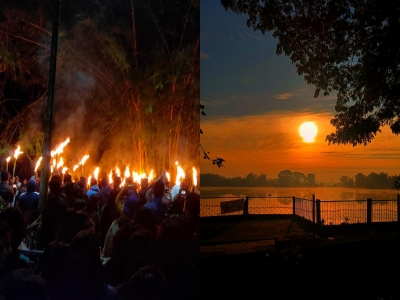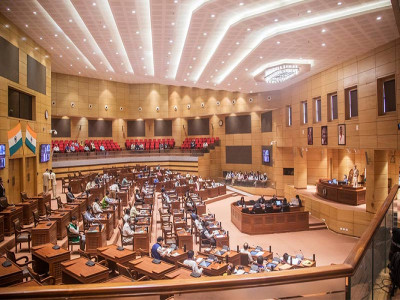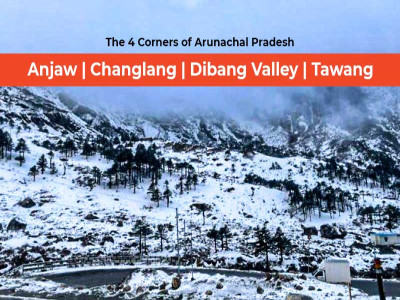
Arunachal Pradesh and its Forest Diversity
The captivating 'Land of the Dawn-Lit Mountains,' Arunachal
Pradesh, is a mesmerising tapestry painted with a myriad of diverse forest
types that stand as a true testament to nature's craftsmanship. Encompassing a
vast expanse of 83,743 square kilometres (32,333 square miles), this state
proudly claims the title of the second-largest forested region in India.
Astonishingly, a staggering 80% of its land area is draped in lush forest
cover, while the remaining 20% is adorned by serene water bodies. This remarkable
landscape shares its borders with Bhutan to the west, China to the north and
northeast, and Myanmar to the east, firmly establishing its pivotal role within
the Northeast region's geographical fabric.
Geographical Significance
Arunachal Pradesh stands as a geographical wonder, sharing its borders with Bhutan to the west, China to the north and northeast, and Myanmar to the east. The state's unique location places it within the transition zone between the Himalayan and Indo-Burmese domains, endowing it with a remarkable blend of ecological influences. This unique positioning has garnered international recognition, placing it among the world's 25 mega-biodiversity hotspots (Myers et al., 2000). Moreover, the Namdapha National Park within its borders has gained accolades from the International World Conservation Union for its role as a significant centre of plant diversity (IUCN, 1995), elevating the state's ecological significance even further.
Arunachal's Forest Type and Biodiversity
The botanical splendour of Arunachal Pradesh, often heralded as a "paradise of the botanists," is showcased through its remarkable floral diversity. Rooted in four broad climatic categories, the vegetation of this region can be classified into five primary forest types, along with a sixth category encompassing secondary forests. These encompass tropical forests, subtropical forests, temperate broad-leaved and coniferous forests, sub-alpine forests, and alpine forests. Notably, even in the degraded forests, a profusion of bamboo and grasses finds common ground.
Deconstructing these classifications, we delve into the six major categories of vegetation that define Arunachal's diverse landscapes:
1. Tropical forests are home to an incredible diversity of species, providing valuable ecosystem services and resources.
2. Subtropical Forests: Generally found in regions with warm and humid climates, they include both broad-leaved and coniferous trees.
3. Temperate Broad-leaved and Coniferous Forests: A mix of both deciduous and evergreen species, found in temperate regions with defined seasons
4. Sub-Alpine Forests: Consists of trees that are adapted to high-altitude conditions with lower temperatures and higher precipitation.
5. Alpine Forests: Found at high elevations above the tree line, they are comprised of hardy, dwarfed vegetation adapted to harsh mountain environments.
Indigenous Dependence
The indigenous communities of Arunachal Pradesh find their sustenance and livelihood intertwined with the land's offerings. Their lives are intricately interwoven with the forests' abundance, which provides them with essential resources. The vegetation of this region aligns itself with four broad climatic categories, resulting in five primary forest types, including the notable subtropical, temperate, and alpine forests.
Forests as Treasure Troves
Arunachal Pradesh's distinctive blend of phytogeography, topography, and climate creates an ideal habitat for a rich variety of flora. This land plays host to approximately 20% of India's fauna, an impressive array of 4,500 flowering plant species, 400 pteridophyte species, 23 conifer species, 35 bamboo species, 20 cane species, 52 Rhododendron species, and over 600 orchid species. These botanical gems find refuge within the state's two national parks and 11 wildlife sanctuaries, covering an impressive 11.68% of its total area.
In the Eastern Himalayas, Arunachal Pradesh stands as a sentinel of forest wealth, beckoning explorations into new realms of plant and animal discovery. Inhabited by tree ferns, bamboo, orchids, and other botanical marvels, the state stands ready for a journey of endless discovery.
Future Prospects and Conservation Challenges
Despite the allure of uncharted territories, the state's dense forests remain relatively unexplored due to the challenges posed by remote locales, rugged topography, and harsh climatic conditions.
The ever-present spectre of climate change adds complexity to Arunachal's biodiversity. Rare, endangered, threatened, and endemic species, with their limited distributions and specific habitats, face an uncertain future. As the climate evolves, these unique species are compelled to adapt, adding urgency to conservation efforts.
What do the latest forest cover statistics for Arunachal say?
According to the ISFR 2021 report from the Forest Survey of India, Arunachal Pradesh's forest cover has experienced a minor decline of 257 square kilometres compared to the 2019 assessment. Across its vast expanse of 83,743 square kilometres, the state proudly boasts a forest cover spanning 66,430.67 square kilometres. Among these, 25.15% are classified as very dense forests, 36.03% as moderately dense forests, and 18.15% as open forests. The remaining 0.95% is attributed to scrubland, which lies beyond the broader calculation.
In Retrospect
Arunachal Pradesh's forests transcend mere visual beauty; they are a treasure trove of biodiversity, embodying nature's intricate artistry. As we reflect on the diverse forest types, their unique inhabitants, and the delicate balance they sustain, we are reminded of the interdependence between humanity and the natural world. Amidst the evolving forces of climate change and the call for environmental stewardship, the imperative for mindful conservation takes centre stage. By safeguarding these forests, we protect not only the state's natural legacy but also the broader ecological heritage of our planet.
Disclaimer: The opinions expressed in this article are those of the author's. They do not purport to reflect the opinions or views of The Critical Script or its editor.

Newsletter!!!
Subscribe to our weekly Newsletter and stay tuned.

















Related Comments